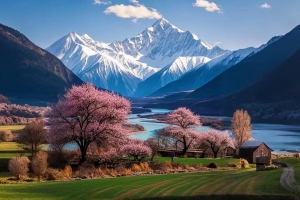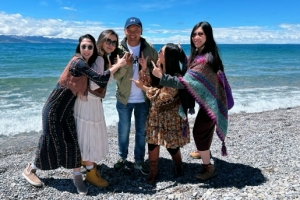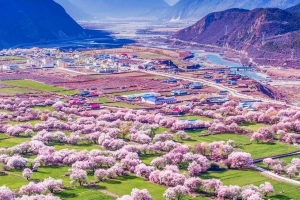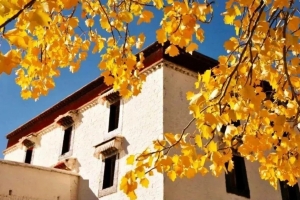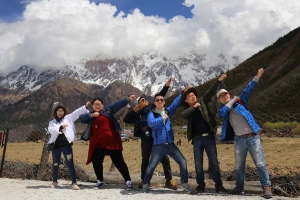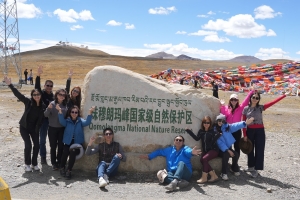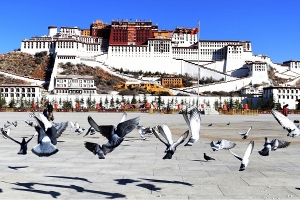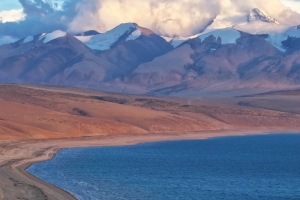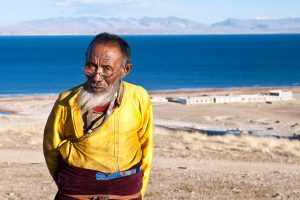Golden-roofed monasteries glisten atop snow-covered peaks, prayer wheels hum softly in the wind, and pilgrims prostrate with unwavering devotion. The highland air feels sacred, every step echoing centuries of faith.
A journey through Tibet’s monasteries is not just travel—it’s a spiritual passage. From Lhasa to Ngari, each monastery is a living scripture, inviting you to discover the beauty of the land and the quiet power of Tibetan Buddhism.
Lhasa: The Beginning and End of Faith
As the capital of Tibet, Lhasa is the first stop for most travelers. It is home to Tibet’s two most iconic religious sites—the Potala Palace and Jokhang Temple. These sacred landmarks are both symbols of faith and destinations for countless pilgrims.
- Potala Palace: A Treasure of Tibetan Culture
Perched atop Marpo Ri (Red Hill), the Potala Palace is a majestic complex that combines palaces, temples, and stupas. Originally built by Songtsen Gampo to welcome Princess Wencheng, it was expanded by the Fifth Dalai Lama and served as the winter residence of successive Dalai Lamas. The Red Palace contains numerous statues, scriptures, and stupas, while the White Palace was used for political and residential functions. Standing atop the palace, gazing over Lhasa, one feels a profound sense of peace and timelessness.
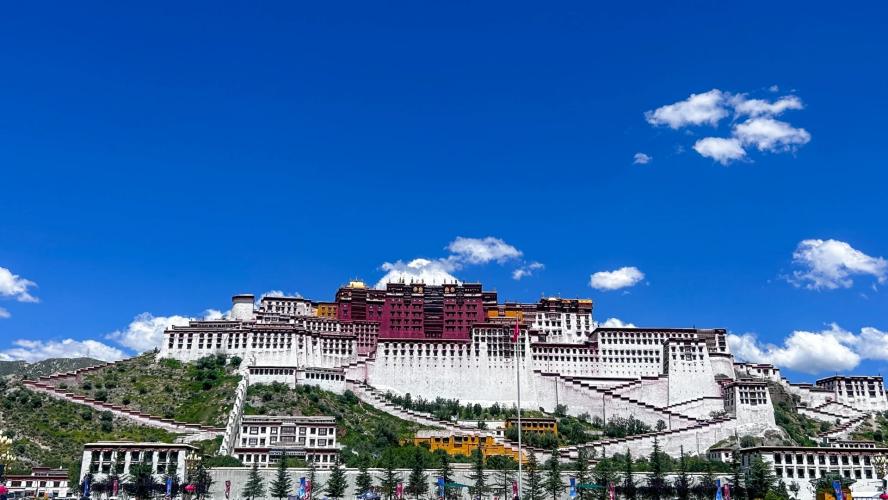
Potala Palace
- Jokhang Temple: A Sacred Place for Pilgrims
Located in the heart of Lhasa’s old town, Jokhang Temple has a history of over 1,300 years. Its main hall houses a life-sized statue of Shakyamuni at the age of twelve—one of the most revered icons in Tibetan Buddhism. Every day, thousands of pilgrims from across Tibet prostrate themselves, spin prayer wheels, and offer prayers, embodying deep, unwavering faith. Just outside lies Barkhor Street, bustling with both worshippers and travelers—a great place to immerse in local customs and urban culture.
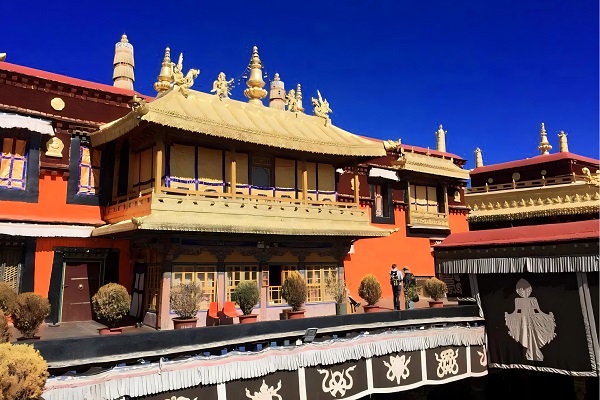
Jokhang Temple
Shannan: The Cradle of Tibetan Buddhism
If Lhasa is the spiritual center of Tibet, then Shannan (Lhoka) is its religious birthplace. Located in the middle reaches of the Yarlung Tsangpo River, Shannan is the origin of the ancient Tibetan kingdom and a cradle of early Tibetan civilization.
Samye Monastery: The First Monastery in Tibet
Founded in the 8th century under King Trisong Detsen, Samye Monastery was the first to feature the complete Buddhist “Three Jewels”: Buddha, Dharma, and Sangha. Its layout symbolizes the Buddhist cosmology with Mount Meru at the center and four colored stupas at the corners. Architecturally, it fuses Tibetan, Chinese, and Indian elements. As the mother monastery of the Nyingma (Red) school, Samye stands as a powerful symbol of Buddhism’s early roots in Tibet.
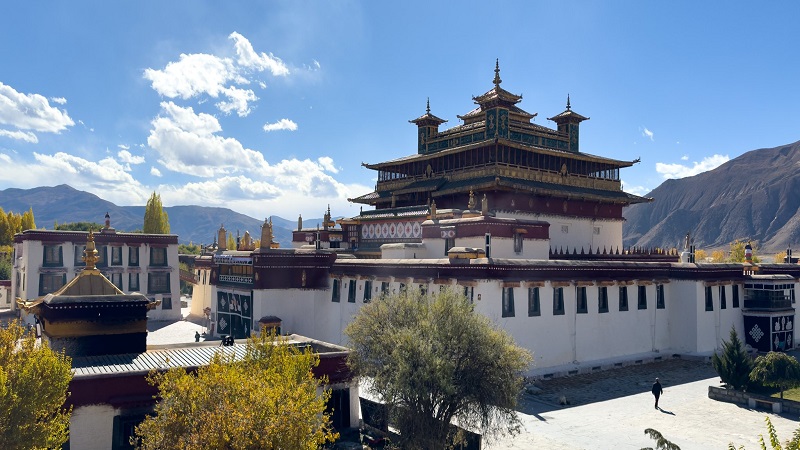
Samye Monastery
Shigatse: A City Illuminated by Dharma
Tashilhunpo Monastery: The Seat of the Panchen Lamas
Established by Gendun Drub, a disciple of Tsongkhapa and the first Dalai Lama, Tashilhunpo Monastery is one of the six great monasteries of the Gelug (Yellow Hat) school and the traditional seat of the Panchen Lamas. The monastery houses the world’s largest copper statue of the Maitreya Buddha, standing 26 meters tall. Intricate murals and a vast collection of scriptures make it a key destination for those seeking to understand Tibetan Buddhist culture. Every year on the 14th day of the fourth lunar month, a grand Buddha Thangka unveiling ceremony draws thousands of pilgrims.
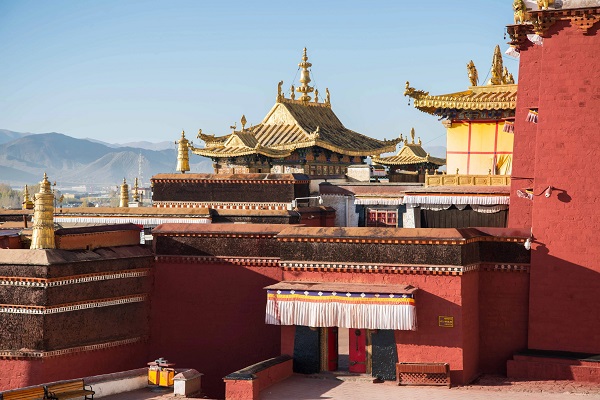
Tashilhunpo Monastery
Ngari: A Beacon of Faith in the Wilderness
Located in far western Tibet, Ngari is vast, sparsely populated, and rugged—yet profoundly spiritual. It is home to Tibet’s oldest cultural relics and some of its most remote sacred temples.
Tholing Monastery and the Guge Kingdom Ruins
Tholing Monastery, established in 996 AD, was one of the first large monastic institutions in Tibet and a hub of Buddhist art during its golden age. Its vividly colored murals combine Indian and native Tibetan styles. Nearby are the ruins of the Guge Kingdom, a city carved into the earth-toned cliffs of the region’s famed “Earth Forest.” Towering structures and cave complexes whisper stories of a once-great Buddhist kingdom. Walking among the remains, one feels transported to a medieval world where faith endured against all odds.

Tholing Monastery
Nyingchi and Chamdo: Tranquil Monasteries in Heavenly Landscapes
Often called the “Jiangnan (River South) of Tibet,” Nyingchi features a moist climate and beautiful natural scenery. Its monasteries are nestled among lakes, forests, and mountains—quiet and serene.
Zatang and Cuogao Monasteries: Hidden Retreats
Zatang Monastery in Gongbo’gyamda County is the only temple in Tibet devoted to the goddess Tara. It features delicate and feminine murals that exude spiritual grace. Cuogao Monastery sits beside Cuogao Lake—its reflection mirrored in the clear waters beneath snow-capped peaks. It’s an ideal place for meditation. Meanwhile, Chamdo’s Zizhu Monastery clings dramatically to a cliffside, commanding awe with its height and grandeur. It is also a key site of the Nyingma school.
Travel Tips and Reminders
- Best Season to Visit
May to October is ideal for monastery travel in Tibet. The weather is mild, roads are more accessible, and visibility is excellent.
- Coping with Altitude
Upon arrival, rest adequately, avoid strenuous activity, and refrain from drinking alcohol. Consider herbal supplements like Rhodiola or take glucose as needed.
- Monastery Etiquette
Remove hats upon entry, speak quietly, and respect monastics. Do not photograph sacred statues without permission. Walk clockwise around temples and prayer wheels unless otherwise specified (such as in Bon monasteries). Avoid stepping over sacred objects.
- Clothing Advice
Temperature differences between day and night are significant. Bring warm clothing even in summer, and dress modestly, especially when visiting religious sites.
A Journey Monastery with Journey2Tibet
Tibetan monasteries are not just sacred landmarks—they are journeys of the soul. At Journey2Tibet, we don’t just take you to places; we guide you into moments of quiet reflection, deep faith, and timeless beauty. Step into this sacred world with us—and discover not only Tibet, but a part of yourself.

